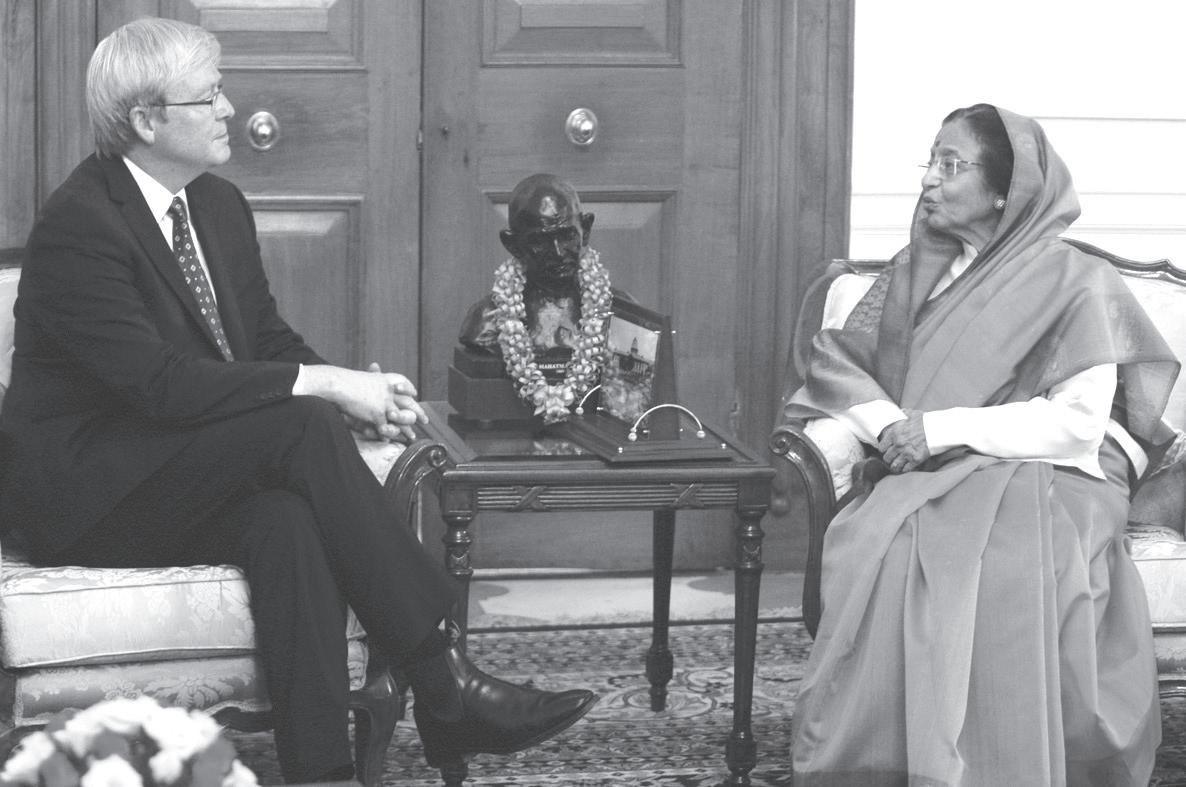
5 minute read
A pact for progress
from 2010-01 Sydney (2)
by Indian Link
DALBIR AHLAWAT chronicles the challenges and prospects that have shaped Australia-India relations up to the present
Over the past decade, AustraliaIndia relations have been in a quagmire, particularly because of the current spate of attacks on Indian students and the conducting of nuclear tests in 1998, which have resulted in critical rethinking in both countries. During the last two years, about nineteen Australian and Indian ministers have exchanged visits, but the outcome has remained merely surfacial. Prime Minister Kevin Rudd’s recent visit to India has resulted in a somewhat substantial understanding, not only in bilateral relations but also in issues related to regional and international fora.
Since India’s independence in 1947 and Australia’s development of independent foreign policy in 1941, both countries shared common goals and values such as liberal democracy, freedom of press, peaceful co-existence, universal application of human rights, nuclear disarmament and respect for international institutions. However, considering the geo-strategic locations and polarisation of international politics, both countries found each other at odds, mainly on the issues of Kashmir, Australia’s alignment with the US and India’s inclination towards the USSR, and Australia’s suspicion of India’s intention to occupy its Coco Islands. This relationship of see-saw continued during the Cold War era. The disintegration of the Soviet Union, India’s liberalisation of its economy and inclination towards the US were factors that forged the Australia-India interests towards convergence. However a big downturn appeared in 1998 when India conducted its nuclear tests; Australia not only reacted fast and sharp, but also got the first rank in calling back its High Commissioner from New Delhi. This reaction was further strengthened by indications that India should sign the Nuclear Non-Proliferation Treaty (NPT). Notwithstanding this, India religiously stood its ground despite mounting pressure from different corners of the world, resulting in Australia issuing a public statement that export of uranium to India would be dovetailed to its signing of the NPT. Now that the US has accorded a special status to India for nuclear exploration, Australia still retains consistency in its policy.

The current spate of attacks on the Indian students and the Indian media’s mounting pressure on their government to tackle the ‘racial’ attacks on Indian students brought the Indo-Aussie relationship to its lowest ebb. Public opinion in India certainly considers Australia as a ‘racist’ country. High level visits by Julia Gillard, Stephen Smith and Kevin Rudd to India and SM Krishna to Australia, assured a higher order for the safety of students and improved quality of Australia’s international education sector worth $15 billion a year. Handling of this issue proved exemplary on both sides. However, it needs to be seen how public opinion about Australia’s image as a “racist” country will be addressed within the Indian public psyche, and in case such incidents are repeated in the future, how the two countries will respond.
Convergence
Canberra and New Delhi are now placed in a predicament and within the evolving global order, both have to work within a broader framework encompassing their ally - the USA, and an emerging robust regional power - China, to play a cooperative role at regional and international levels. During Stephen Smith’s visit to India, the two foreign ministers in the sixth Australia-India Foreign Ministers’
Framework Dialogue reiterated a higher level of understanding on bilateral, regional and international cooperation. A feasibility study on a Free Trade agreement between Australia and India was also given a final consideration.
With current bilateral trade of around $19 billion, India is heading to be Australia’s third largest export market. Witnessing the trends, two-way investment continues to grow in new sectors like energy, information technology and biotechnology. Furthermore, the evolving trade relationship can be gauged by an agreement signed in August 2009 between India’s Petronet LNG and Exxon-Mobil. Under this $20 billion agreement, 1.5 million tones of liquefied natural gas will be supplied to India each year for 20 years.
Canberra and New Delhi have to seriously consider the issues of nuclear non-proliferation, India’s stance of remaining firm in not signing the NPT and on the issue of export of uranium to India
Strategically also, with the balance of power shifting towards Asia and increased organised terrorist activities, the two countries have much to share. India’s geo-strategic location ensures a transit of half of the world’s maritime trade through the Malacca and Lambok Straits. Innumerable smaller islands in the Indonesian archipelago provide sanctuaries to arms dealers and contraband merchants, so India could help Australia not only in protecting sea-lanes for safe passage of commercial vessels, but also in patrolling the high seas for drug and human cargo traffickers.
Challenges
Australia and India share membership of the Indian Ocean Rim countries, G20, the ASEAN Regional Forum and the East Asia Summit, and common issues such as climate change, use of clean energy, fighting against terrorism and peaceful coexistence.
Initially, Australia has been invited by India, the leading member of the South Asian Association for Regional Cooperation (SAARC) to be an observer at its meetings. This accelerated Australia to Look-West and develop a better understanding of the region.
India has been lobbying for the reformulation of international institutions to represent the modern day world. It has emphasised on reformulation of the UN and its agencies and has consistently claimed its place as a permanent member of the UN
Security Council. In addition, since the early 1990s India has been seriously pursuing the Look-East policy to be actively involved in Asia Pacific affairs and acquire membership of the Asia Pacific Economic Cooperation (APEC).
Australia has assured India of its support, but it needs to be seen how Australia will respond to the issues of climate change and terrorism because both countries have varying understanding of these issues. For example, though both share perceptions on abating terrorism it needs to be seen whether Australia is in a position to shift its policy stand on Kashmir and support India vis-àvis its neighbours.

Conclusions and Cautions
Australia understands that the balance of power is shifting towards the AsiaPacific, mainly with the India and China as emerging powers. This view was aptly reinforced by Indian Prime Minister Manmohan Singh saying, “The 21st century will be an Indian Century. The world will once again look at us with regard and respect”. This was further reinforced by Stephen Smith, when he frankly admitted the anomaly that “for many decades, Australian Governments underappreciated India, its potential and its importance for the future not just of our region, but of the world.” Perhaps this may be corrected in time by supporting India’s claims for permanent membership in UNSC and APEC. Notwithstanding increasing cooperation and assurances of support, Canberra and New Delhi have to seriously consider the issues of nuclear nonproliferation, India’s stance of remaining firm in not signing the NPT and on the issue of export of uranium to India.
Also, will Australia be able to maintain a relationship with India in the wake of signing a free trade agreement with China? No doubt, consistent and appreciable efforts are being made to address the student issue and attempts are being made to bridge cultural gaps; however this issue is capped, yet not resolved. Perhaps it should be researched in-depth involving both Indians and Australians and the claim of “racist” attacks be addressed.
Against this backdrop, both countries should be assuring and commit only what they can honour, because simply signing Memoranda of Understanding, as has been the trend in the past, will not suffice in progressing the Indo-Australian relationship.










